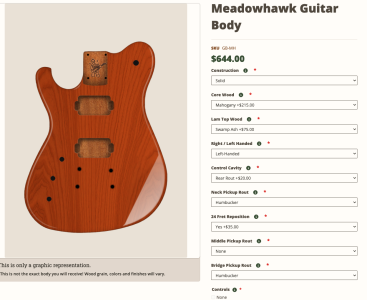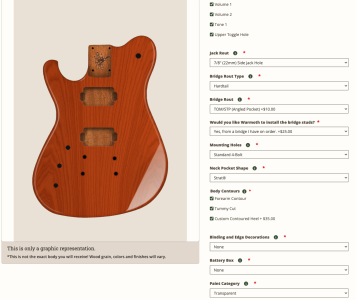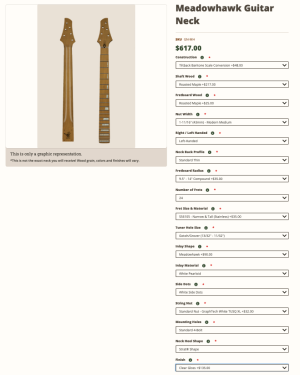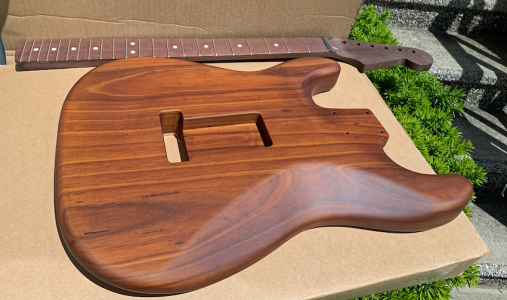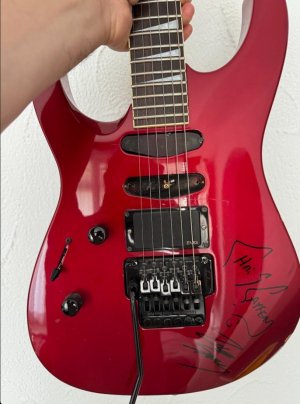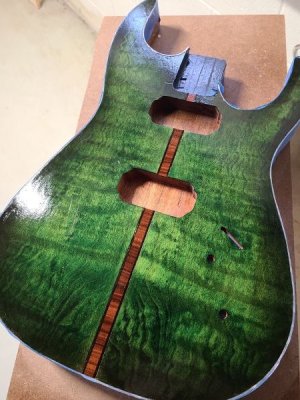Hello everybody.
I apologise in advance for my English, I’m Italian.
I’d like to make my first build (the release of the Meadowhawk has been a very bad thing for my wallet), but I have so many question that I thought to do a big post in order to gather all my doubts, please tell me if this is against the forum rules, this is my first post and first visit, I had a look at the rules, but you know...
Before posting, I watched a lot of videos from Aaron and I read quite a lot on the website, but I’m still a bit confused.
I am trying to build a left handed-baritone guitar, at the moment I’m playing a superb Rivolta Mondata VII baritone, but there’s still some things that I don’t quite like.
I’ll start with the body (screenshots below with the specs):
Neck (screenshots below with the specs):
That’s it I guess, thank you to everybody in advance.
As soon as February comes, I’ll place my order
Cheers from the other side of the pond.
I apologise in advance for my English, I’m Italian.
I’d like to make my first build (the release of the Meadowhawk has been a very bad thing for my wallet), but I have so many question that I thought to do a big post in order to gather all my doubts, please tell me if this is against the forum rules, this is my first post and first visit, I had a look at the rules, but you know...
Before posting, I watched a lot of videos from Aaron and I read quite a lot on the website, but I’m still a bit confused.
I am trying to build a left handed-baritone guitar, at the moment I’m playing a superb Rivolta Mondata VII baritone, but there’s still some things that I don’t quite like.
I’ll start with the body (screenshots below with the specs):
I’ll wire it as follows:
bridge volume (push-push)
neck volume (push-push)
tone - only for the neck
is it possible to have just one tone and have the bridge tone 100% “open”?
With push-push pots do I have a visual indication that, for example, the split of the pickup is activated?
Bridge:
I wanted a Gotoh 510, but I cannot find a left-handed one, so I gave up and I’ll go with this (both gold):
- TonePros Tune-o-matic bridge
- TonePros stop tail piece
do they fit baritone strings? The option for the bridge route is correct?
Jack route: I don’t understand what I should order/do, any advices?
Pickups: I’ll decide later, but 90% they will be a Dimarzio Super Distortion and some kind of PAF. I’m looking for some Tim Shaws (I have them on my Gibson custom 1981) but they are hard to find. 100% I want them to be both splittable.
I do not need to buy the F-spaced pickups, correct?
Colour: on the bottom, “satin or gloss” option is missing. It will be gloss.
I want something similar to my Schecter PT Van Nuys but slightly darker, should I get maybe roasted swamp ash? Does somebody has a pic of a (roasted) swamp ash build in transparent amber/red/vintage tint/brown?
Neck (screenshots below with the specs):
I cannot find anywhere the length scale of a Warmoth baritone neck. 28 inches?
Tuners: I cannot find locking tuners that will fit baritone strings, so I picked the Gotoh SG381 3+3 set (in gold), should be ok I guess..? No staggered posts needed right?
Frets: I don’t understand if I will need to do a fret job after the next has been put on the guitar with strings or not even with stainless steel frets (probably just a language barrier).
What exactly do I need to buy to file the nut for a baritone?
Roasted maple: if I understood correctly, I DO NOT need to apply anything else (hard finish) more than the finish I want Warmoth to apply right? I just need to polish it from the frets and the neck is good to go…?
That’s it I guess, thank you to everybody in advance.
As soon as February comes, I’ll place my order
Cheers from the other side of the pond.



